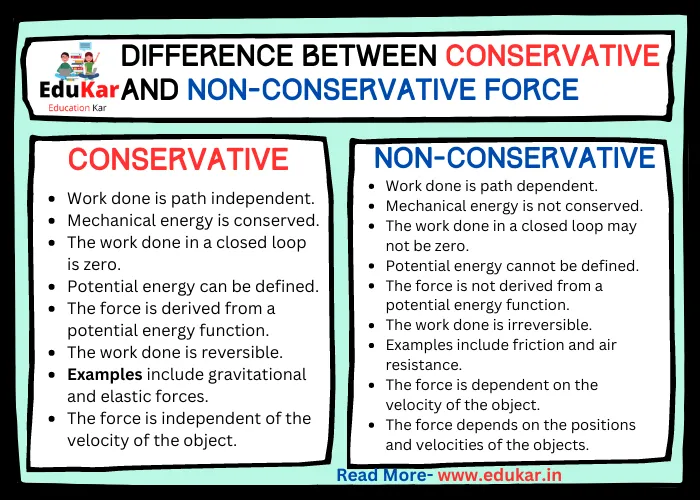In physics, conservative and non-conservative forces are two types of forces that act on objects. Understanding the difference between these two types of forces is important for predicting the motion of objects. This article by Edukar explores the definitions of conservative and non-conservative forces, their characteristics, and their effects on objects.

Introduction
When an object is in motion or at rest, it is under the influence of various forces acting upon it. These forces determine the state of the object and its motion. In order to understand the behavior of objects in motion and their interactions, it is necessary to classify these forces into different types. Two major types of forces are conservative and non-conservative forces.
Also Read: Difference Between Displacement and Double Displacement Reaction
Conservative Forces
Conservative forces are those that depend solely on the position of an object, and not on its velocity or acceleration. These forces are path-independent, meaning the work done by them is independent of the path taken by the object. Conservative forces also conserve mechanical energy, which means that the total amount of energy in the system remains constant. Examples of conservative forces include gravity and the spring force.
Characteristics of Conservative Forces
The characteristics of conservative forces are as follows:
- They are path-independent.
- They are always attractive.
- They do not dissipate energy.
- The work done by them is equal to the change in potential energy.
- The total mechanical energy of the system is conserved.
Non-conservative Forces
Non-conservative forces are those that depend on an object’s velocity and acceleration, and not just its position. These forces are path-dependent, which means that the work done by them is dependent on the path taken by the object. Non-conservative forces do not conserve mechanical energy, meaning that the total amount of energy in the system does not remain constant. Examples of non-conservative forces include friction and air resistance.
Also Read: Difference Between Regular and Irregular Reflection
Characteristics of Non-conservative Forces
The characteristics of non-conservative forces are as follows:
- They are path-dependent.
- They can be either attractive or repulsive.
- They dissipate energy.
- The work done by them is not equal to the change in potential energy.
- The total mechanical energy of the system is not conserved.
Differences between Conservative and Non-conservative Forces
| Point | Conservative Force | Non-Conservative Force |
|---|---|---|
| 1 | Work done is path independent | Work done is path dependent |
| 2 | Mechanical energy is conserved | Mechanical energy is not conserved |
| 3 | The work done in a closed loop is zero | The work done in a closed loop may not be zero |
| 4 | Potential energy can be defined | Potential energy cannot be defined |
| 5 | The force is derived from a potential energy function | The force is not derived from a potential energy function |
| 6 | The work done is reversible | The work done is irreversible |
| 7 | Examples include gravitational and elastic forces | Examples include friction and air resistance |
| 8 | The force is independent of the velocity of the object | The force is dependent on the velocity of the object |
| 9 | The force depends only on the positions of the objects | The force depends on the positions and velocities of the objects |
| 10 | The force does not dissipate energy | The force dissipates energy |
Summary
Conservative and non-conservative forces are two major types of forces that play an essential role in the behavior of objects in motion. Understanding the characteristics, examples, and differences between these forces is crucial for the design and operation of machines, vehicles, and structures. As we continue to develop new technologies and structures, the study of forces and their interactions will become increasingly important.
Also Read: Difference Between Resistor and Resistance
FAQs
What is a conservative force?
A conservative force is a force that does not depend on the path taken by an object, only on its initial and final positions. The work done by a conservative force is path-independent.
What is a non-conservative force?
A non-conservative force is a force that depends on the path taken by an object. The work done by a non-conservative force is path-dependent.
What is the difference between conservative and non-conservative forces?
The main difference between conservative and non-conservative forces is that the work done by conservative forces is independent of the path taken, while the work done by non-conservative forces is dependent on the path taken.
Can conservative and non-conservative forces exist together?
Yes, it is possible for an object to experience both conservative and non-conservative forces simultaneously.
What happens to the total mechanical energy of an object in the presence of conservative and non-conservative forces?
In the absence of external work done on the system, the total mechanical energy of an object in the presence of conservative forces remains constant. However, in the presence of non-conservative forces, the total mechanical energy of an object decreases over time.




